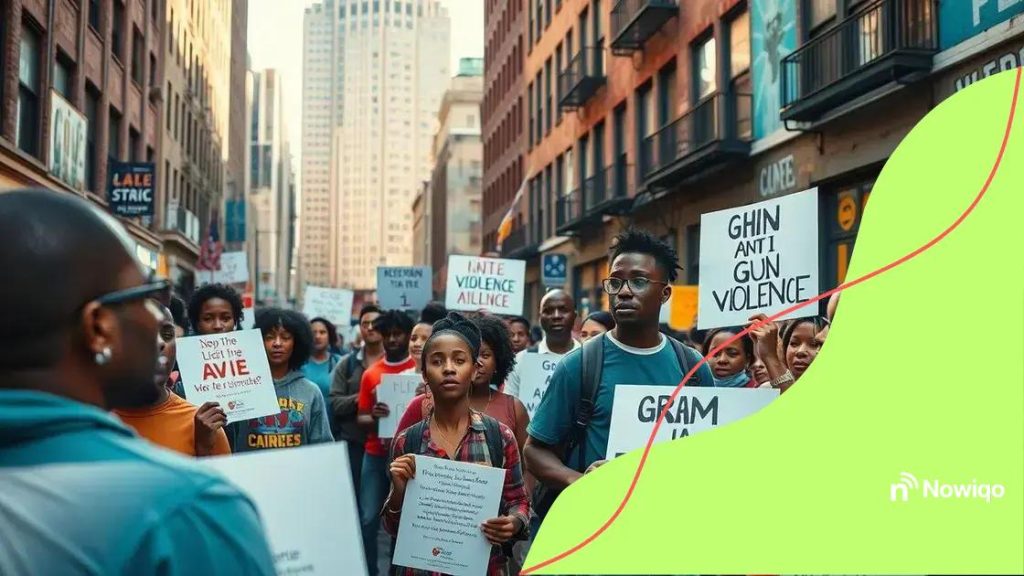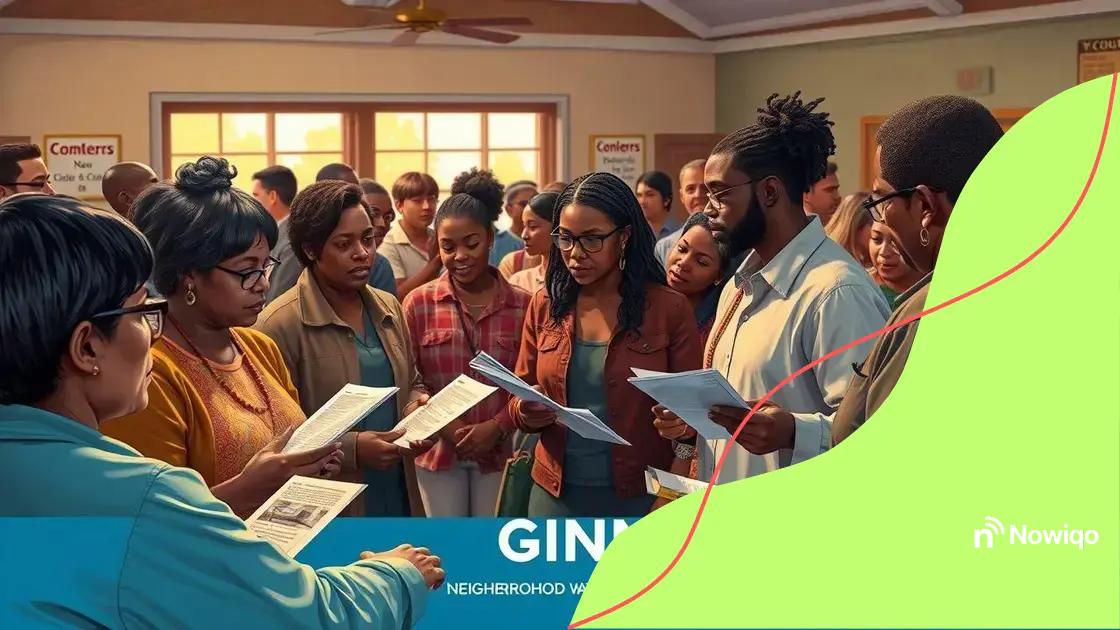Gun violence prevention progress: what you need to know

Anúncios
Gun violence prevention involves community initiatives, supportive policies, and effective measurement of programs to significantly reduce incidents and promote safety in neighborhoods.
Gun violence prevention progress is a critical topic that impacts countless lives. By exploring effective strategies and community efforts, we can find hope and resilience amidst the challenges. Are you curious about how these initiatives are reshaping neighborhoods?
Anúncios
Understanding gun violence: the current state
Understanding gun violence is crucial to addressing its impact on communities. In recent years, data has shown alarming trends, prompting conversations around prevention and reform. Let’s explore the current state of gun violence and its implications.
Statistics on Gun Violence
Recent statistics shed light on the severity of gun violence. Every year, thousands are affected, whether through direct involvement or the broader consequences in society. Here are some key points:
- Increasing Rates: In many areas, incidents of gun violence have increased, often correlating with socioeconomic factors.
- Demographic Disparities: Certain demographics face higher risks, highlighting the need for targeted interventions.
- Urban vs. Rural Differences: Gun violence manifests differently across urban and rural settings, each presenting unique challenges.
Community perspectives on this issue are varied. Some residents advocate for stricter regulations, while others emphasize the importance of addressing the root causes, such as poverty and lack of education. Understanding these viewpoints is essential for effective discussions around gun violence prevention.
Anúncios
Factors Contributing to Gun Violence
Numerous factors contribute to the ongoing challenges presented by gun violence. Among these are:
- Poverty and Employment: Areas with high unemployment rates often see higher crime rates, including gun violence.
- Access to Firearms: Easy access to guns can escalate conflicts, making it easier for violence to occur.
- Social Norms: Community attitudes towards violence can influence behavior among individuals, perpetuating cycles of crime.
To tackle the issue of gun violence, understanding the complexity of these factors is critical. Policymakers and community leaders must engage with residents to create effective strategies that address both immediate and underlying problems.
Key strategies for gun violence prevention
Key strategies for gun violence prevention focus on understanding the root causes and implementing effective measures. These strategies can greatly enhance community safety and well-being. Let’s delve into various approaches that have shown promise.
Education and Awareness
Educating the community about the risks and consequences of gun violence plays a vital role in prevention. Awareness campaigns can inform individuals about safe practices and the importance of responsible gun ownership. By increasing knowledge, communities can foster a culture that discourages violence.
Community Engagement
Engaging local communities in discussion and action is essential for addressing gun violence. Building trust among residents allows for open dialogue about safety concerns. Community-driven initiatives, such as neighborhood watch programs, can empower residents to take an active role in prevention.
- Collaborative Events: Organizing events that bring community members together can strengthen bonds and encourage collective action.
- Partnerships with Local Organizations: Collaborating with nonprofits and schools can amplify outreach efforts and provide resources.
- Feedback Mechanisms: Establishing avenues for residents to voice their concerns helps tailor prevention strategies to specific community needs.
Policy changes are another critical component in the fight against gun violence. Advocacy for stricter gun laws can help reduce access to firearms for those who should not possess them. This includes background checks and limitations on high-capacity magazines.
Support Services and Resources
Providing support for those affected by gun violence is also crucial. Resources such as counseling and legal assistance can aid victims and their families. Ensuring these services are accessible promotes healing and stability within affected communities.
Incorporating mental health support into violence prevention strategies is pivotal. Programs that focus on mental health can help identify and address underlying issues before they escalate into violent actions. By providing suitable interventions, communities can significantly reduce the risk of future incidents.
Community initiatives making a difference

Community initiatives play a vital role in addressing gun violence. These grassroots efforts not only raise awareness but also foster collaboration among residents to create safer environments. Let’s explore some impactful initiatives that are making a difference.
Neighborhood Watch Programs
Neighborhood watch programs empower residents to take action against crime, including gun violence. These programs provide a platform for community members to work together, enhancing safety through vigilance. Here are some key components:
- Active Participation: Residents are encouraged to report suspicious activities and take part in regular community meetings.
- Building Trust: By fostering relationships among neighbors, these programs create a sense of security and collective responsibility.
- Collaboration with Law Enforcement: Engaging local police helps ensure that concerns are addressed promptly and effectively.
In addition to neighborhood watches, there are programs focused on youth engagement. Connecting young people with positive role models can deter involvement in violence. Many organizations offer mentorship and skill-building activities that empower youth and provide constructive outlets.
Violence Interruption Programs
Violence interruption programs aim to stop violence before it starts. Trained community members, often referred to as “interrupters,” intervene in potentially violent situations. Their familiarity and trust within the community can significantly reduce instances of gun violence.
These programs focus on conflict resolution and mediation. By addressing disputes early, they can prevent escalation that might lead to violence. Additionally, providing support services for those involved can help to change cycles of violence.
Local art and awareness campaigns also contribute to community efforts. By utilizing creative forms of expression, communities can communicate messages about the impacts of gun violence. Events like art shows, concerts, and workshops invite participation and raise awareness in a meaningful way.
Resource Centers
Establishing resource centers within communities offers individuals crucial support systems. These centers provide access to services such as job training, counseling, and legal aid, which are vital in preventing violence. When residents have resources to improve their lives, the likelihood of gun violence decreases.
Through collaboration, creativity, and community spirit, these initiatives are making significant strides in the fight against gun violence. Each program reinforces the importance of collective action in creating safe neighborhoods.
The role of policy in prevention efforts
The role of policy in preventing gun violence is critical. Policies set the framework for how communities respond to and manage violence. Effective legislation can create safer environments for individuals and families.
Stricter Gun Control Laws
Implementing stricter gun control laws is one way that policymakers can significantly impact gun violence. These laws help regulate who can purchase firearms and under what circumstances. Important components of gun control include:
- Background Checks: Requiring thorough background checks before anyone can buy a gun helps prevent firearms from getting into the hands of those with criminal records or mental health issues.
- Waiting Periods: Instituting waiting periods can assist in cooling off heated emotions during conflicts and reduce impulsive decisions to use firearms.
- Limitations on Assault Weapons: Banning or restricting access to high-capacity firearms reduces the potential for mass shootings and gun violence.
In addition to these measures, effective policies must consider local contexts. Communities need tailored approaches that address specific issues they face regarding gun violence.
Support for Research and Data Collection
Another essential policy component is investing in research and data collection on gun violence. Understanding the causes, locations, and demographics of gun violence allows policymakers to create informed responses. This data can also guide funding for evidence-based programs that have shown success in reducing violence.
Additionally, fostering partnerships between law enforcement, community organizations, and public health agencies can enhance these efforts. By working together, stakeholders can create comprehensive strategies to tackle gun violence.
Policies that promote education and community involvement are also vital. Lawmakers can create programs that educate citizens about the risks of gun violence and ways to prevent it. These efforts can empower local communities to take action and drive change.
Community-based Policy Advocacy
Community-driven advocacy plays a critical role in shaping gun violence prevention policies. When residents voice their needs and priorities, it helps influence legislative agendas. Grassroots organizations often mobilize communities to campaign for safer environments through various methods.
Engaging residents in advocacy ensures that policies reflect the unique challenges faced by different neighborhoods. This approach leads to more relevant and effective strategies to combat gun violence.
Measuring success in prevention programs
Measuring success in prevention programs for gun violence is essential to understanding their effectiveness. Evaluating these programs helps identify what works, what doesn’t, and how to improve initiatives aimed at reducing violence.
Key Metrics for Evaluation
To assess the impact of prevention programs, specific metrics should be established. These metrics provide quantifiable data that can guide future decisions. Important metrics may include:
- Reduction in Incidents: Tracking changes in gun violence incidents in a community can reveal the effectiveness of a program.
- Community Engagement: Measuring participation rates in programs indicates how well the community is responding to prevention efforts.
- Behavioral Changes: Surveys or studies that assess shifts in attitudes toward violence and gun ownership can show long-term impacts.
Analyzing these metrics helps policymakers understand the breadth of a program’s impact. Additionally, qualitative data, such as personal testimonies from community members, can complement these findings.
Data Collection Techniques
Effective data collection methods are vital for evaluating prevention programs. Utilizing various techniques can ensure a comprehensive understanding of a program’s effects. Common methods include:
- Surveys and Interviews: Gathering feedback from community members who participated in programs can provide insights into their experiences and the perceived effectiveness of the initiatives.
- Statistical Analysis: Employing statistical methods to analyze crime reports provides concrete data for assessing trends in gun violence.
- Focus Groups: Conducting discussions with diverse community members allows for in-depth exploration of issues surrounding violence and prevention strategies.
Incorporating both quantitative and qualitative approaches gives a well-rounded view of a program’s performance. It also helps identify specific areas needing improvement.
Adapting Based on Findings
Once data is collected and analyzed, adjustments may be necessary to enhance prevention efforts. Programs should remain flexible, adapting to the community’s evolving needs based on evaluation results. Ensuring continuous improvement keeps the fight against gun violence relevant and effective.
Establishing a feedback loop where communities can share their experiences can lead to more responsive strategies. Collaboration between policymakers, organizations, and community members fosters an environment where everyone’s voice matters.
FAQ – Frequently Asked Questions about Gun Violence Prevention
What are some effective community initiatives for gun violence prevention?
Effective initiatives include neighborhood watch programs, youth engagement efforts, and violence interruption strategies that empower communities to take action.
How does policy impact gun violence prevention efforts?
Policies play a vital role by setting regulations for firearms, supporting research, and funding community programs focused on reducing violence.
Why is measuring success in prevention programs important?
Measuring success helps identify effective strategies, ensures accountability, and guides improvements in programs aimed at reducing gun violence.
What role does education play in preventing gun violence?
Education raises awareness about the risks of gun violence, promotes responsible gun ownership, and encourages community involvement in prevention efforts.